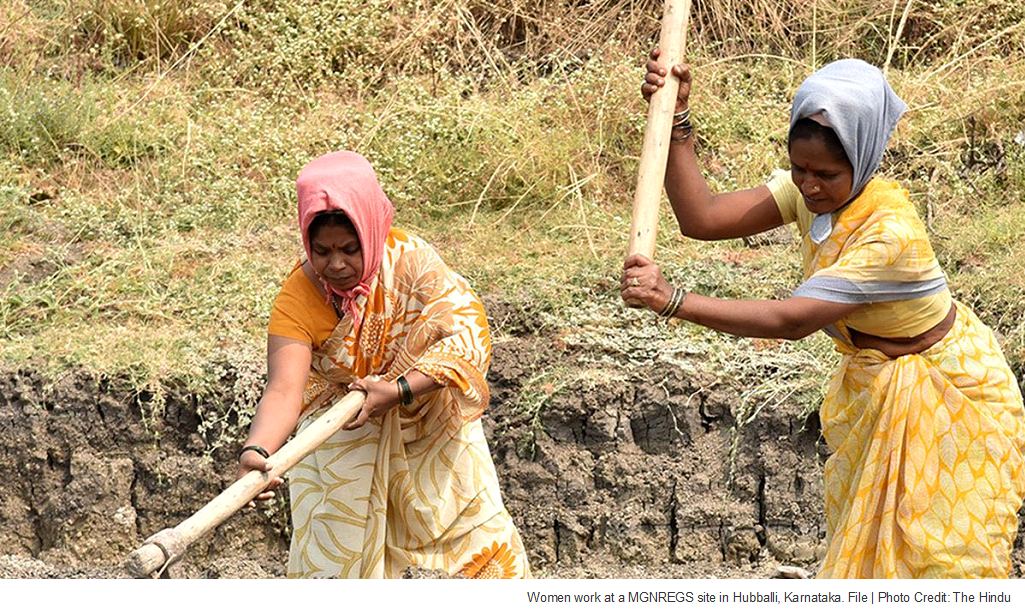Fall and rise in women’s work participation
08 Mar 2024
Opinion: Sonalde Desai and Pallavi Choudhuri.
Instead of debating the cause of the fall and the rise in the proportion of women farmers and family helpers, we should look to expand women’s opportunities outside of agriculture, which are better paying.
Arguably, the debate around trends in Indian women’s employment is only outclassed by a similar one regarding trends in poverty. Unfortunately, the scrutiny of the measurement of poverty is not matched by similarly close attention to the measurement of employment.
The broad contours of the debate, mainly relying on data from the National Sample Surveys (NSS) and Periodic Labour Force Surveys (PLFS), are the following: the work participation rate for women ages 15 and above fluctuated around 42% between 1993-94 and 2004-05, declined to 28% in 2011-12, and plummeted to 22% in 2017-18. From 2017, it miraculously surged, and reached 36% in 2022-23.
Two contrasting narratives
In an era of heightened politicisation of statistics, these observations became a ping- pong between pessimists and optimists. The pessimistic story explained the decline in women’s work participation as a sign of declining job availability and later increase as a sign of poverty. The optimistic story painted the initial decline as a sign of growing prosperity, allowing women to focus on their families, and the surge as a sign of increasing job opportunities. Others have tried to see this as a natural transformation of the economy chronicled by Claudia Goldin’s famous U-shaped curve where women are displaced from the labour market as the agricultural workforce moves to industrial employment, with female employment rebounding with the service economy again making space for them.
We must examine the foundation of these narratives. We see a striking trend when we break down the 25-59-year-old women’s work participation into three categories: self-employment in agriculture, self-employment in other activities, mainly in petty manufacturing or shopkeeping, and wage and salaried work in manual or white-collarwork.
Women’s work on family farms dropped from 23% to 10% between 1993 and 2017. During the era of increasing employment, the work on family farms bounced back to 23%, thus more than doubling in the last five years. Wage labour and self-employment in non-farm work remained more or less steady at 14-16% and 5-6%, respectively, although we see a slight upward trend in wage employment in recent years. So, most of the changes are driven by the ebbing and flowing tide of women’s work on family farms.
But questions about principal and subsidiary activity status are alien for rural women whose day is full of demands for bathing and feeding children, fetching water, washing cattle, harvesting grains, and making pickles for sale. The interviewer’s job is to provide context and ask questions that elicit information about the key indicators of interest. For example, a study by the National Council of Applied Economic Research traced the impact of question-wording on women’s work participation rate. Women’s work participation was initially measured using NSS-style questions and later through probing questions. This increased the rural women’s work participation rate from 28% to 44% for the same women. Most of the omissions were of women who were self-employed in agriculture and animal care.
Historically, these challenges were addressed by relying on trained and experienced field investigators who learned to interpret their questions, keeping local conditions in mind. However, India’s once-vaunted statistical system has been in crisis. As Pramit Bhattacharya noted, until the late 1990s, interviewers were regular employees recruited locally. Since then, supervisors have been centrally recruited and often posted in areas they may not be familiar with, and interviewers are short-term contractual workers hired locally. This has led to a steep decline in quality, culminating in the government disputing the quality of the NSS consumption expenditure survey in 2017-18. A recognition of the declining quality of NSS surveys may have led to increasing attention to data quality, as evidenced by the increase in the strength of subordinate statistical services from 2,181 officers in 2009-10 to 3,121 in 2019-20. This suggests that increased attention to capturing women’s work on family farms rather than an actual increase in farm work accounts for the doubling of women farmers over a short period of five years.
The counterargument
A counterargument might be that this increase is due to economic shifts, particularly men’s movement out of agriculture, creating space for women. Yet, a modest decline in male self-employment in farming, from 33% to 25%, occurred between 2004-05 and 2017- 18, when the female work participation rate also declined. Since then, the proportion of men classified as farmers/family helpers has increased slightly, accompanied by a much more significant increase for women. Instead of debating the cause of the fall and the rise in the proportion of women farmers and family helpers, attention needs to focus on the relative stagnation in the proportion of women who are wage workers (around 16%) and owners/family helpers of small businesses (around 6%) and seek to expand women’s opportunities outside of agriculture, which is generally better paying.
Sonalde Desai is Professor at the National Council of Applied Economic Research (NCAER); Pallavi Choudhuri is Senior Fellow at NCAER. Views are personal
Published in: The Hindu Business Line, 08 Mar 2024






